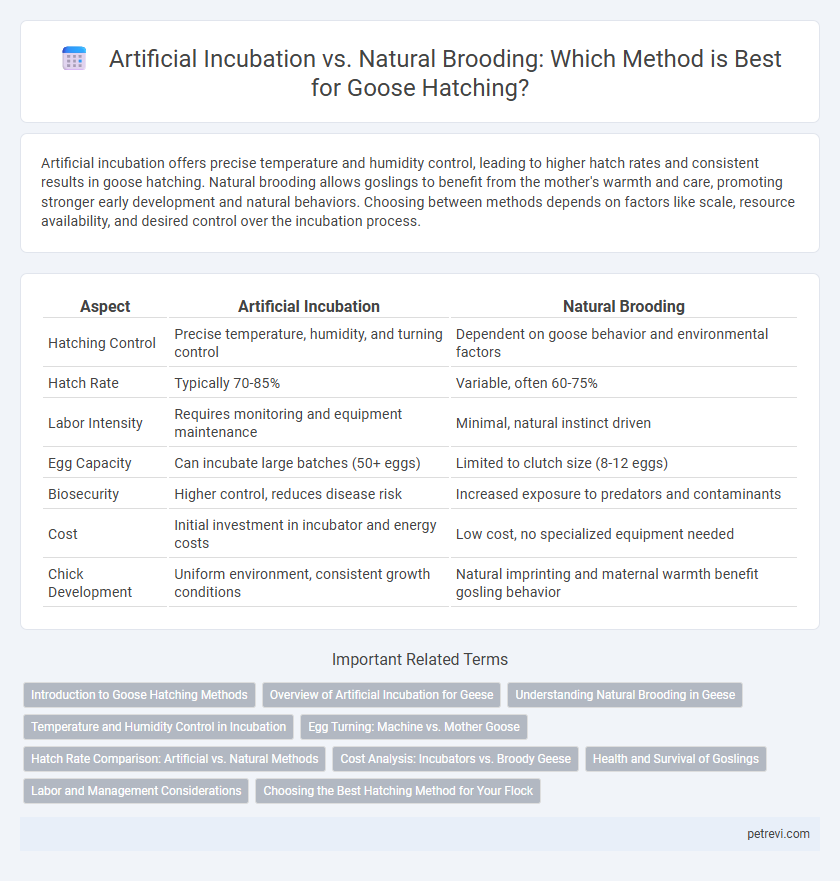Artificial incubation offers precise temperature and humidity control, leading to higher hatch rates and consistent results in goose hatching. Natural brooding allows goslings to benefit from the mother's warmth and care, promoting stronger early development and natural behaviors. Choosing between methods depends on factors like scale, resource availability, and desired control over the incubation process.
Table of Comparison
| Aspect | Artificial Incubation | Natural Brooding |
|---|---|---|
| Hatching Control | Precise temperature, humidity, and turning control | Dependent on goose behavior and environmental factors |
| Hatch Rate | Typically 70-85% | Variable, often 60-75% |
| Labor Intensity | Requires monitoring and equipment maintenance | Minimal, natural instinct driven |
| Egg Capacity | Can incubate large batches (50+ eggs) | Limited to clutch size (8-12 eggs) |
| Biosecurity | Higher control, reduces disease risk | Increased exposure to predators and contaminants |
| Cost | Initial investment in incubator and energy costs | Low cost, no specialized equipment needed |
| Chick Development | Uniform environment, consistent growth conditions | Natural imprinting and maternal warmth benefit gosling behavior |
Introduction to Goose Hatching Methods
Artificial incubation for goose hatching involves controlling temperature, humidity, and turning eggs mechanically to optimize embryo development, resulting in higher hatch rates and uniformity. Natural brooding allows geese to incubate their own eggs, providing natural warmth and protection but often leading to lower hatch rates and variable timing. Understanding the differences in these methods helps improve hatching efficiency and gosling survival rates in commercial and small-scale operations.
Overview of Artificial Incubation for Geese
Artificial incubation for geese involves controlled environmental conditions that optimize temperature, humidity, and turning frequency to enhance hatching success rates. Modern incubators use precise thermostats and automated turning mechanisms to mimic natural brooding, reducing risks of egg damage and predation. This method enables higher consistency in hatchability and allows for large-scale production of goslings while minimizing the dependency on the mother goose.
Understanding Natural Brooding in Geese
Natural brooding in geese involves the female incubating eggs using her body heat and regulating temperature through consistent positioning, which enhances embryo development and hatch success. This process maintains optimal humidity and aeration, critical factors for healthy gosling emergence. Understanding these natural behaviors helps improve artificial incubation protocols to better mimic conditions that maximize hatch rates and gosling vitality.
Temperature and Humidity Control in Incubation
Artificial incubation of goose eggs requires precise temperature control around 37.5degC and consistent humidity levels between 55-65% to ensure optimal embryo development and hatchability rates. Natural brooding by the goose involves gradual temperature adjustments influenced by the mother's body heat, often resulting in slight fluctuations in humidity that can affect incubation time. Maintaining stable temperature and humidity in artificial incubation systems minimizes risks of embryo mortality and promotes uniform gosling growth compared to the variable conditions of natural brooding.
Egg Turning: Machine vs. Mother Goose
Artificial incubation uses automated egg turning mechanisms to ensure consistent rotation, promoting uniform embryo development and preventing yolk adhesion. In contrast, natural brooding by a mother goose involves instinctual, gentle turning that mimics natural environmental cues, enhancing hatchability through adaptive temperature and humidity regulation. Machine turning offers precise control and scalability, while maternal brooding provides biological feedback that can improve chick vitality.
Hatch Rate Comparison: Artificial vs. Natural Methods
Artificial incubation of goose eggs typically achieves a hatch rate of approximately 70-85%, surpassing natural brooding, which ranges from 50-65% depending on the breed and environmental conditions. Controlled temperature and humidity settings in artificial incubators optimize embryonic development, minimizing losses caused by external factors or inconsistent maternal care. However, natural brooding provides eggs with adaptive temperature fluctuations and maternal behaviors that can enhance chick vitality despite a generally lower hatch success rate.
Cost Analysis: Incubators vs. Broody Geese
Artificial incubation incurs initial costs for purchasing and maintaining incubators, along with electricity expenses, while offering controlled temperature and humidity for higher hatch rates. Natural brooding by geese eliminates equipment costs but may result in lower hatchability and higher labor intensity due to the need for constant care and protection. Cost efficiency depends on scale, with artificial incubation favored for large-scale hatching and natural brooding preferred in small or traditional operations.
Health and Survival of Goslings
Artificial incubation of goose eggs provides controlled temperature and humidity, reducing risks of fungal infections and improving hatch rates, which enhances the overall health of goslings. Natural brooding allows goslings to receive maternal warmth and protection, promoting stronger immune system development and higher survival rates in natural environments. Combining artificial incubation with brief natural brooding can optimize gosling health and survival by balancing environmental control and maternal care.
Labor and Management Considerations
Artificial incubation of goose eggs demands consistent monitoring of temperature, humidity, and turning schedules, requiring specialized equipment and skilled labor to ensure optimal hatch rates. Natural brooding relies on the goose's maternal behavior, reducing human labor but necessitating careful flock management to maintain hen health and minimize egg disturbances. Balancing labor input and management complexity is critical, as artificial incubation offers scalability while natural brooding provides cost-effective, low-intervention hatching solutions.
Choosing the Best Hatching Method for Your Flock
Artificial incubation offers precise temperature and humidity control, increasing hatch rates and allowing large-scale goose hatching without reliance on a broody goose. Natural brooding provides the benefits of maternal care, including warmth, protection, and guidance, enhancing gosling survival and early development. Selecting the best hatching method depends on flock size, available resources, and management goals, with artificial incubation suited for commercial operations and natural brooding ideal for small, traditional flocks.
Artificial incubation vs Natural brooding for Goose Hatching Infographic

 petrevi.com
petrevi.com